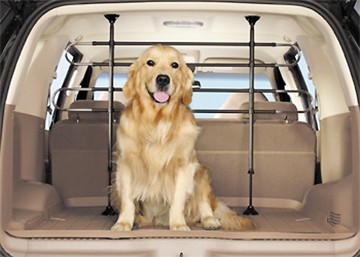Driving to Distraction

Most dogs love a ride in the car. While we automatically buckle up for safety, our dogs roam the car at will, hanging out the window, climbing into the front seat and sometimes into our laps. They don’t care if we’re driving.
Sometimes, we don’t either.
A 2011 survey by the American Automobile Association and Kurgo, a manufacturer of pet travel products, examined dog owners’ habits behind the wheel. The survey found that our buddies are too often creating a dangerous distraction.
Nearly six in 10 (56 percent) have driven with their dog at least once a month in the past year; 52 percent admit to petting their dog(s) while driving.
Nearly one in five dog owners (19 percent) admit to taking their hands off the wheel to keep dogs from climbing in the front seat.
Nearly one-quarter (23 percent) have used their hands or arms to hold their dog in place while applying brakes.
The survey revealed other distracting behaviors, like drivers reaching into the back seat to interact with their dog (18 percent), allowing their dog to ride in their lap or holding their dog (17 percent) or feeding them treats (13 percent). Three percent say they’ve taken pictures of their dog while driving. Wag for the camera, Fido.
Like their incautious drivers, unrestrained pets are accidents waiting to happen.
“Drivers should use a pet restraint system every time their dog is in the vehicle,” says Christine Delise, spokeswoman for AAA Mid-Atlantic. “A restraint will not only limit distractions but also protect the driver, the pet and other passengers in the event of a crash or sudden stop.”
Only 16 percent of drivers use a pet restraint. Two in five said they don’t use a pet restraint because their dog is a peaceful passenger.
But the calmest dog will be thrown with the same amount of force as a rowdy one. An unrestrained 10-pound dog in a crash at only 30 mph will exert roughly 300 pounds of pressure. An 80-pound dog will exert approximately 2,400 pounds of pressure. Ouch.
“Dogs riding in back seats will be thrown over the seat in a sudden stop,” says Grant Nisson of Muddy Creek Animal Hospital in West River. “A 60-pound dog going at 30 mph can cause critical harm to the dog and to anyone sitting in front of him.”
Other reasons cited for not using a restraint include: never considered it (39 percent); just take dog on short trips (29 percent); and dog wants its head out the window (12 percent).
Riding with your head out the window is fun — “until something gets lodged in your eyes or ears,” Nisson says. “And on some of our area’s narrow roads, dogs can get a pretty good smack in the head from a branch.”
Holding those little dogs in your lap as you drive? Not a good idea, either.
“Airbags were designed to protect human drivers,” Nisson says. “A deployed airbag can smoosh a little dog, breaking its neck, legs and then some.”
Dogs riding in the way-back cargo area of SUVs should be crated — and the crates anchored to the floor of the car — so they don’t become part of the forward-flung danger.
At the least, install a removable barrier between the back seat and storage area or the back and front seats.
“One of these barriers will stop the dog’s forward movement,” Nisson says. “It will limit the distance a dog can fly through the car and protect passengers from a missile of furry flesh.”
When you buckle up for safety, don’t forget your furry passengers. A variety of reasonably priced products can help you keep your pets safe and your doggy distraction down.
